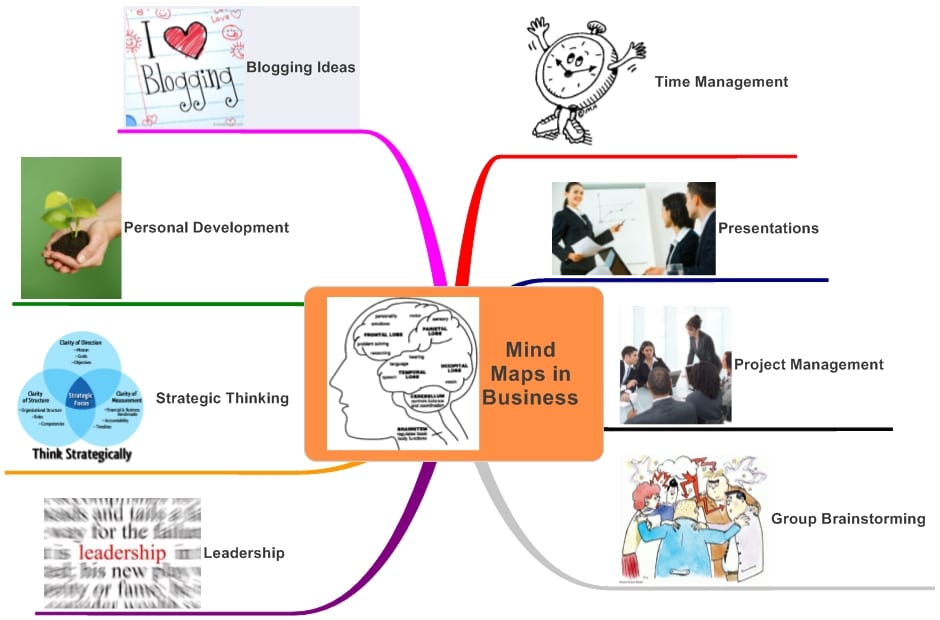A few years ago I was introduced to Mind Maps by a colleague as a way of organising and structuring my thoughts. It took me some time, but eventually I’ve got to a place where I am using Mind Maps consistently both in my professional and personal life.
For those of you who have never come across Mind Maps before it’s worth having a quick look at an overview on this Wikipedia page, before reading the rest of my post.
I will now share with you some thoughts I have about where Mind Maps can be used effectively in business
Related: 12 Ways To Improve Productivity At The Workplace
-
Time Management
Mind Maps are a great way to quickly draw up an overview of your yearly, monthly, weekly and daily objectives. I find Mind Maps a great way to visually prepare the upcoming week, and plan my priorities for each day. I’ll usually do this on a Monday, print it out and stick it on the wall above my monitor, where it is easy to see.
-
Presentations
A Mind Map is mnemonic by nature ie. it’s a memory tool that works for you as a presenter, and for your audience. It can be used at the start to give a big picture of what will be covered, referred to again at certain key points, and used as a way to summarise key points at the end. Personally I haven’t yet taken the step of presenting to an audience using Mind Maps, but increasingly I’ve been using them in one to one presentations, most notably with my manager and colleagues when I’m trying to get an idea or concept across to them.
-
Project Management
Recently my manager has started giving me more project management responsibilities. I’ve never had any formal project management training, however I’ve increasingly found myself using Mind Maps at certain phases of the project. It has been really helpful in scoping the project, and keeping track of the main milestones. However I’ve found it less useful for task management. I have done some research and found some Mind Mapping software that integrates task management, so this is something that I could return to in the future.
-
Group Brainstorming
One of the problems I see with group brainstorming is the tendency for some individuals to take a back seat and let others come up with all the ideas. I recently worked on a project with some colleagues, which at one point required brainstorming, to generate ideas. All of us were familiar with Mind Mapping, so before jumping straight into a group discussion, we decided to create individual Mind Maps where we could gather our own thoughts on the subject. The group discussion then started with each person doing a 5-10 minute presentation of his/her Mind Map. I found this approach much better at getting ideas out in the open, and most importantly, getting everyone to contribute.
-
Become a Better Leader
Part of being a good leader is being an effective communicator. I’ve been a recent convert to “The Apprentice”, and I’m currently watching both the UK and Irish shows. One of the things I really like about the show is seeing where things have gone wrong, and hearing the feedback that teams get in the boardroom. In a lot of cases, failure in the early tasks is down to poor communication among sub-teams. Mind Maps is an excellent tool for communicating the objective of a project, the different tasks involved, and most importantly the role and function of everyone in the team.
-
Strategic Thinking
Back in my university days we studied quite a few strategic models e.g. The Product Life Cycle, SWOT analysis, The Marketing Mix (4Ps), PEST (macro environment analysis). When I discovered Mind Maps, it struck me that they provide a fantastic format to create, modify, display and share the strategic level ideas from these models.
-
Personal Development
I’ve recently been utilising the Getting Things Done (GTD) methodology as a way of becoming more productive both at work and at home. One of the things that I’ve picked up from GTD is the importance of taking a step back and getting the big picture in terms of your goals, objectives and development. I’ve found Mind Maps to be an excellent way to capture such high level thinking, on a single page. I’ve printed this out and put it on my wall, so that I can have a daily reminder of what’s important, in the long term.
-
Blogging Ideas
I have a single Mind Map which I use to capture all my ideas for blogging topics. Each week when deciding a topic to write about, I simply open the Mind Map and pick something out of my idea bank.
Related: 5 Ways To Develop Productive Work Environments
So as you can see there are many opportunities where Mind Maps can be used in the world of business. If you’ve floated on the periphery of Mind Mapping and want to know more I’d highly recommend that you check out the book that really made me take Mind Maps seriously. It’s called Use Your Head by Tony Buzan.
I’d be keen to know your thoughts on Mind Maps. What do you think of the tips? Can you see yourself using Mind Maps in these ways? Are you already using Mind Maps? If so, how? Let us know via the comments.
Did you like this article? Sign up for our RSS, like us on Facebook or follow us on Twitter


